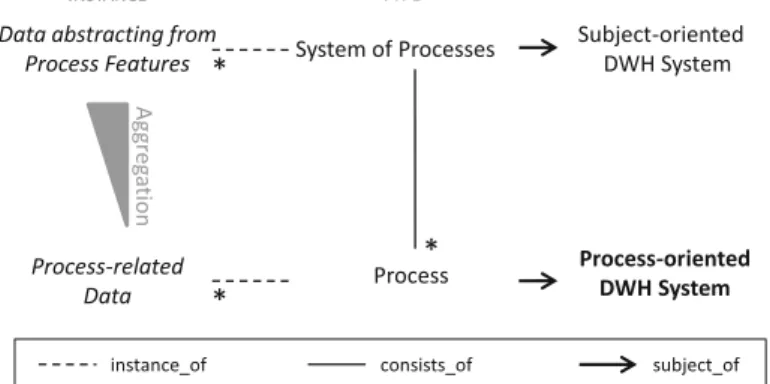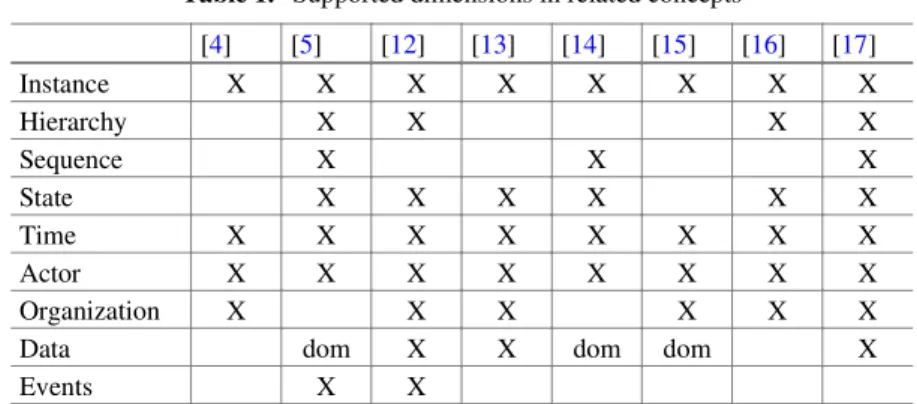for BPMN Workflows
Thomas Benker
(✉
)Chair of Business Information Systems – Systems Engineering
Otto-Friedrich-University of Bamberg, An der Weberei 5, 9047 Bamberg, Germany thomas.benker@uni-bamberg.de
Abstract. Companies in dynamic environments have to react to certain market events. Reactions can be short-term and influence the behavior of running process instances or they can be mid-term or long-term and cause the redesign of the process. In both situations, insights into the process flow are necessary and provided by Process Data Warehouse Systems. This paper proposes to derive the data warehouse structures from the meta model of the BPMN (Business Process Model and Notation), the actual de-facto standard of workflow languages. The resulting data structure is generic in order to be portable between application domains and to be stable in case of changing workflows.
Keywords: Process data warehouse system · Data warehouse schema · Business Process Model and Notation · Workflow
1 Introduction
Data Warehouse Systems (DWH systems) are established in most companies. They are used to support strategical and tactical decisions at managerial level by providing rele‐
vant multidimensional information. The multidimensional data model enables the aggre‐
gation and analysis of quantitative measures (e.g., number of sales) along qualitative dimensions (e.g., region, customer group or time). The schema design is aligned to certain areas of business decisions and analysis. The measures are provided aggregated and abstracted from concrete business transactions or processes.
Companies in highly competitive and dynamic markets often have to react appro‐
priately and with an adequate latency to changing conditions [1]. Process Data Ware‐
house Systems (PDWH systems), a specialization of subject-oriented DWH systems, are appropriate to optimize business processes and operations on a daily or intraday basis [2]. They can be used to support the identification of changing conditions as well as the design of adequate reactions by providing insights into the processes. The difference to the subject-oriented DWH concept is shown in Fig. 1. A PDWH system focuses on a certain process type while subject-oriented DWH systems are providing data abstracted from process type information. This is also true of the data instances. A PDWH system has a lower aggregation level and explicitly provides data that is related to a process and its behavior. Processes are executed by Workflow Management Systems (WfMS). These systems also keep track of the execution and enable some runtime monitoring and
© Springer International Publishing Switzerland 2016
W. Abramowicz et al. (Eds.): BIS 2016, LNBIP 255, pp. 222–234, 2016.
DOI: 10.1007/978-3-319-39426-8_18
restricted analytical functions at a technical level. But they are restricted in case of business level analysis in order to support the following PDWH scenarios: The behav‐
ioral (operational) scenario describes short-term reactions that influence the behavior of running process instances. The structural scenario describes the mid-term or long-term redesign of the process structure based on data of finished instances [3]. The process relationship is the common basis as well as the multidimensional data structuring. E.g., [4, 5] motivate multidimensional structures for the structural scenario. For the behavioral scenario the multidimensional data model is proposed to analyze process events in a historical context [6, 7]. Of course, the data structure has to be extendable with scenario- specific information.
Fig. 1. Distinction of subject- and process-oriented DWH systems
The term process is rather unspecific in the context of PDWH systems. The term workflow is more precise and better suited. A workflow is understood as a special kind of process that is designed to be executed by humans or WfMS. Basically, it is described by activities and their relationship [8]. Workflow languages are close to the executing systems and for this appropriate as basis to derive multidimensional structures. The Business Process Model and Notation (BPMN) [9] is one of the dominant workflow modeling languages [8]. The OMG (Object Management Group) standard is widespread and accepted by modelers and tool developers [10]. But the BPMN has not been consid‐
ered so far in multidimensional process data structures.
The goal of this paper is to present a multidimensional data structure in order to
realize the following requirements: First, the data structure should support decision
making in the behavioral and the structural PDWH scenario. Second, it should support
the workflow language BPMN. And finally, the multidimensional structure should be
flexible in order to react on dynamically changing workflow schemas. The strategy to
realize these requirements is to derive the multidimensional data structure based on the
BPMN meta model. Of course, it has to be enhanced with business information. Further,
the data structure will be specified to be generic. This means that it is independent of
the workflow schema. First, this enables the application in heterogeneous business
domains (e.g. sales or human resources). Second, the redesign of a workflow schema
due to changing market conditions does not imply the redesign of the DWH schema.
The benefit is that existing reports are repeatable and results are reproducible. This is a key feature of DWH systems (e.g. in case of compliance checking). The redesign of DWH structures often has a negative influence on repeatability and reproducibility.
To introduce the generic PDWH schema, the paper is structured as follows: First, the relevant basics of the BPMN are introduced. Section 3 is a discussion of related work. Section 4 presents the concept of the generic PDWH schema that is applied and demonstrated in Sect. 5 on a real-world case study. Finally, Sect. 6 summarizes and reflects the concept and gives an outlook on future work.
2 The Business Process Model and Notation
PDWH systems focus on process behavior and interaction between processes. The BPMN provides process (workflows) and collaboration diagrams for this purpose [11].
The other diagram types are not relevant for the research problem. The BPMN also defines conformance classes in order to determine the conformance between modeling tools and the specification. To control the complexity of the BPMN in this work, the focus of the presented concept is reduced to the elements of the descriptive process modeling conformance class. This class defines the basic concepts for process and collaboration modeling. Section 6 shortly explains the extension of the concept to support the full process modeling conformance. The meta model for the conformance class is based on the BPMN specification [9] and shown in Fig. 2.
Fig. 2. The relevant part of the BPMN meta model (representation based on [9])
Flow Nodes [9, 11]: Flow Nodes are the building blocks of BPMN process models.
Activities are used to model working steps. A Task represents an atomic working step
that can be described more closely as user, service, send or receive task. A Sub-Process
is a non-atomic working step and encapsulates a process itself. A Call Activity is used
to model a callable and reusable process. Gateways control the flow of the process. An exclusive gateway splits/joins alternating sequence flows. Parallel gateways create/
synchronize parallel sequence flows. Events of a process are differentiated by their posi‐
tion (start, intermediate, end) and their trigger. Relevant events are the empty start/end event, the message start/end event, the timer start event and the terminate end event.
Sub-types of Task, Event and Gateway are not shown in Fig. 2.
Connecting Objects [9, 11]: The Sequence Flow is used to model the process behavior.
A Sequence Flow element always runs from a start to a target Flow Node. The interaction between processes is modeled by Message Flows with optionally annotated message descriptions.
Lanes [9, 11]: A process is contained within a Pool that represents a participant of a collaboration. A Pool can be hierarchical structured by Lanes. Typically, they are used to model roles or responsibilities within a process.
The Data Objects of the BPMN specification are left out of this work. The BPMN semantics of the term Data are not precise enough and because of this not operable. The element Data is not only used to annotate input/output data. Even more, it is used to assign physical objects and products. Further, the BPMN does not provide the possibility to specify data structures like UML Class Diagrams or Entity Relationship Models. But such data structures could be important to identify business dimensions. Because of this, Sect. 5.2 demonstrates the derivation of business dimensions based on object-oriented operational structures.
3 State of the Art
A number of publications are presenting multidimensional data structures for workflow schemas. A first group of publications base their concepts on informal [12] or proprietary [4, 13] workflow specifications. The authors of [14] present a generic multidimensional schema. The used workflow specification is kept abstract. The proprietary workflow specifications are often incomplete, restricted and only for theoretical usage. A second group of concepts is defined for certain application domains. Multidimensional data structures for surgery workflows are presented in [5]. In [15] parts of multidimensional data structures for service and sales processes are introduced. Because of their domain- specific contexts, the portability to other application domains is restricted. The authors of [16] base their concept on the workflow specification of the WfMC (Workflow Management Coalition). The multidimensional data structures are not specified in general terms. They are designed to support assumed queries. The data structure of [17]
abstracts from application domain and process language. It is designed for the identifi‐
cation of information requirements based on generated process data. Due to the abstrac‐
tion from language specifics it is limited for tracking and analyzing relevant processes data at runtime.
The presented approaches support heterogeneous workflow concepts as dimensions
(Table 1). Only few approaches support the analysis of the hierarchical structures or of
the sequence flow of the workflows. Data usage is mostly considered rudimentary or only domain-specific. The dimensions Time, Actor and Instance (Assignment of node instances to workflow instance) are supported in all proposals. Yet, the BPMN has not been considered in related work. Compared to the BPMN, the used workflow specifi‐
cations and multidimensional structures are restricted. E.g., the interaction between participants/processes is not subject of any of the concepts. Furthermore, the related multidimensional structures are not defined based on a formal specification and, for this, could not be checked for completeness. A further feature of the BPMN is its clearly defined and human readable graphical syntax. This is important for process redesign in order to localize workflow elements that, for example, have been identified to be inef‐
ficient. The related publications do not discuss workflow specifications with an appro‐
priate graphical syntax compared to the BPMN.
Table 1. Supported dimensions in related concepts
[4] [5] [12] [13] [14] [15] [16] [17]
Instance X X X X X X X X
Hierarchy X X X X
Sequence X X X
State X X X X X X
Time X X X X X X X X
Actor X X X X X X X X
Organization X X X X X X
Data dom X X dom dom X
Events X X
X → feature is realized; dom → domain-specific realization

![Fig. 2. The relevant part of the BPMN meta model (representation based on [9])](https://thumb-eu.123doks.com/thumbv2/1library_info/3867138.1518524/3.659.63.578.491.776/fig-relevant-bpmn-meta-model-representation-based.webp)




